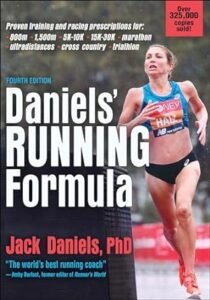If you’re planning for your next marathon, you might want to consider a Jack Daniels marathon training plan. The 2Q plan is challenging yet flexible, and it could be the right choice to push you to a new PR.
There are a bunch of marathon training plans out there in books and on the internet. It can be a bit confusing to figure out which one is right for you. Let me break it down for you with a deep dive into one good option – the Jack Daniels 2Q plan.
Note: This post focuses specifically on marathon training. You can find an overview of Jack Daniels half marathon training plans here.
Where Can I Learn More About Jack Daniels Marathon Training Plans?
Jack Daniels wrote several books about running, but his work has been consolidated into one main book that is still in print – Jack Daniels Running Formula. This book contains Jack Daniels’ marathon training plans.
There are a few different options, but 2Q is the most popular one. Note that the 4th edition of Running Formula was released last year, but there were no changes in this plan since the 3rd edition. There are some significant changes from the 2nd edition. I’d recommend sticking with the 3rd or 4th editions.
In Running Formula, Jack Daniels details his research into VO2 max and running economy. He describes the different physiological systems that impact running performance and he explains how to train each of them. He then provides a large variety of training plans, targeting race distances from 800m all the way up to marathons.
The book also contains a chart you can use to determine your VDOT score – which in Jack Daniels’ system determines the what training paces you should use for various types of workouts. Although you can look this up online using the VDOT calculator, it’s nice to have everything in one chart.
Before you use one of the Jack Daniels running plans, you should definitely read the book. You’ll have a much better understanding of why you’re doing certain things, and you’ll be better able to understand what the plans are asking you to do.
I’ve also written about Jack Daniels running formula here, and I’ve shared my own experience using 2Q here.
What Makes a Jack Daniels Running Plan Special?
All marathon training plans are going to share some similarities – high mileage and weekly long runs. But there are a few things that set Jack Daniels 2Q apart from the others.
The first is his VDOT system. Some training philosophies revolve around race paces – like 5k or half marathon pace. But Jack Daniels breaks everyone run down into one of five paces – E (Easy), M (Marathon), T (Threshold), I (Interval), and R (Repetition). You can plug a recent race result into the VDOT calculator or the chart in the book and all of your training paces will be set for you. No need to worry about things like tracking your heart rate or calculating percentage of pace differentials.
Another thing that makes the 2Q plan unique is its flexibility. In a given week, Jack prescribes two quality workouts, a total amount of mileage, and that’s it. You plan out the rest of the week, spreading the easy miles across however many runs you want.
A third difference takes a pretty conservative view of long runs. In the book, he advises that there’s little point to running longer than 2 hours. Although he does occasionally allow for a run of up to 2.5 hours, he places much less emphasis on the length of long runs. Unless a runner is very fast or is used to running extremely high mileage, JD places much less emphasis on long runs of 20 or more miles.
Finally, Jack Daniels 2Q plans don’t include a lot of built in recovery or tapering. There’s a short taper at the end, but it is not very aggressive. And there is some variation of weekly mileage, but unless you make a choice to drop a particular workout you’ll still have two intense workouts every week.
Overview of the JD 2Q Marathon Training Plan
The Jack Daniels 2Q training plan is 18 weeks long. Each plan is defined by a peak mileage – 40, 55, 70, 85, 100, 120, and more than 120. Each week of the plan is defined by three things – a fraction of peak mileage, the first quality workout, and the second quality workout.
The fraction of peak mileage tells you how much to run that particular week. So if you’re running the 55 mpw plan, and the week is designated as 0.9 of peak mileage, you would run approximately 50 miles.
The first quality workout is the long run for the week, and it usually involves a workout portion. The second quality workout is another medium long or long run, and again it usually involves a workout. The length of these runs, as well as the intensity of the workouts, will vary depending on which peak mileage you chose. So the workouts in the 55 mpw plan are relatively tame compared to those in the 100 mpw plan.
But the quality workouts do follow the same pattern, regardless of the peak mileage. The Q1 runs are typically marathon pace runs, threshold workouts, or occasionally straight easy runs. The Q2 runs are typically more threshold work or faster interval and/or repetition work. The majority of the workouts focus on marathon and threshold running, since that’s the most important for marathon performance. But every couple weeks an interval and/or repetition workout is sprinkled in just to prevent you from losing too much top end speed.
The plan does not include a lot of planned recovery, but it does highlight some workouts that are optional. Jack explains that you can skip these workouts if you need additional recovery time. So you can choose to incorporate more recovery, and you if you need it you should definitely do so.
The final week of the plan is a taper leading up to the race. It’s a minor thing, but important to note, that each week goes from Sunday to Saturday. You would typically run Q1 on Sunday, and you would typically run Q2 on Wednesday or Thursday. You would run the race on the Sunday following the final week of the plan.

Are You Ready for a Jack Daniels Running Plan?
The plans are intense, and the volume and intensity ramp up quickly. You don’t want to be reaching for new heights in the middle of the plan.
Before starting a 2Q marathon training plan, you should be comfortable running the mileage in the first week with some intensity mixed in. You’ll be even better off if you do some easy base building at the peak mileage.
For example, you’d be ready for the 55 mile per week plan as long as you can comfortably run 45 miles per week with some intensity mixed in. You’d be better off if you’ve run 50 or 55 miles per week at some point, even if it was all easy miles.
If you’re not sure if you’re ready for the intensity of the plan, you could also consider a Pfitz marathon training plan. They’re also very challenging, but the Jack Daniels 2Q plan involves significantly more quality work. Pfitz can be a good way to grow into a new peak mileage and progress as a runner, whereas Jack Daniels is better for realizing your potential once you’re already comfortable at a given mileage.
A Sample Week from Jack Daniels 2Q Training Plan
Reading Jack Daniels 2Q marathon training plan can be a bit strange for the uninitiated, but once you understand his system it’s pretty simple. Each pace (E, M, T, I, R) is determined by your VDOT, and each workout involves a combination of these five paces for various distances.
For example, In the 55mpw plan, here is the entry for 12 weeks to go until race day:
- Fraction of Peak: 1.0
- Q1 – 2E + 6M + 1E + 6M + 1E (16 miles)
- Q2 – 6E + 3T + 3 min E + 2T + 2 min E + 1T + 2E (14 miles)
This is a peak week – meaning that you would run approximately 55 miles.
The first quality workout is a marathon pace workout. You warm up with two easy miles, run six miles at marathon pace, recover for a mile, then run another six miles at marathon pace, and finish up with a mile cool down. Your overall mileage for the day should be approximately 16 miles.
The second quality workout is a threshold workout. You start with a long six mile warm up. Then you run three miles at threshold, recover for three minutes easy, followed by two miles at threshold, two minutes easy, one mile at threshold, and a two mile easy cool down.
It is worth noting here that Jack suggests that for slower runners – in other words, the mortals among us who aren’t 2:20 marathoners – you substitute 5 minutes at threshold for each mile. Depending on your actual T pace, this may or may not be a big deal. But it will also change the workout distances a little bit, and if you revise down the distance of the T portions you’ll have to increase the warm up or the cool down.
For the remaining miles – in this case, 25 – it’s up to you to split them across the remainder of the week. I’d probably go with five runs of four to five miles for this week. But you can choose to beef up individual runs if you want a day off or split some of the mileage into doubles if you want to avoid longer weekday runs.
Pros of the Jack Daniels 2Q Plan
If you’re looking for an advanced marathon training plan, there’s a lot to like about the 2Q plan.
It’s flexible. This is the greatest selling point for me. My work schedule varies, and some days I have more time in the morning than others. I only have to worry about one mid-week workout. But I can shuffle around which day that falls on, and I can adjust the weekly mileage of the other days pretty easily.
It’s demanding. The quality workouts will definitely put you through your paces, and if you can complete these workouts you will be in amazing shape come race day. Between all of the marathon and threshold work, you should end up with a really good idea of what you are capable of.
It’s simple. The VDOT calculator makes it very simple to plan your workout paces. You don’t have to worry about heart rate measurements or calculations of paces relative to specific race results. Just plug a recent race into the calculator, or use a realistic goal time, and you’ll have your five paces.
Cons of the Jack Daniels 2Q Plan
But there are reasons that people dislike the plan.
It’s not a cookie cutter. The same way that the flexibility appeals to me, it doesn’t appeal to other people. If you’re looking for someone to tell you how many miles to run every day, this is not the plan for you.
The second quality workout is too long. If you don’t have a lot of time on weekday mornings, then 2Q may not be for you. You’re also going to have trouble with a plan like Pfitz, which includes a medium long run. But you might be able to get away with a workout in the morning and a double in the evening (or vice versa).
The workouts are confusing. There are a lot of steps in some of the workouts. Some people complain about this complexity. If you go with JD 2Q, you should definitely get a GPS running watch like a Garmin Forerunner. This will allow you to program detailed workouts into your watch and get prompts for each step.
The long runs aren’t long enough. If you’re a passionate believer in the 20 mile long run, 2Q may not be the plan for you. You won’t see any 20 mile runs until 70mpw, and then it’s only twice. JD’s long runs are a little shorter, but they are more intense.
The Q workouts don’t scale well at low mileage. Although a 40 mpw plan is included in the book, I’ve heard a lot of complaints from people. The length of the two Q workouts don’t leave a lot of easy mileage to fill in. The plan starts to make sense at 55 mpw, and it hits a sweet spot around 70 mpw. I’d avoid this if you aren’t ready for at least 55 mpw.
Bottom Line on JD’s 2Q Marathon Training Plan
The bottom line is the 2Q Jack Daniels marathon running plan is both flexible and intense.
If you’re an advanced runner who’s looking to challenge yourself in your next training block, 2Q might be a good choice. If you want the flexibility to rearrange the week, then 2Q is definitely a good choice.
While this is definitely not a beginner plan, it could work for your first marathon if you have a sufficient base from training for shorter distances. It’s a good choice for first time marathoners who are already experienced runners.
However, if you’re looking for a detailed day by day plan, this is not the choice for you. Pfitz might be a better choice for you.
If you’re not quite ready for 55 mpw, then you might want to look elsewhere. The Hansons beginner plan might be a better choice.
If you don’t have two hours for a midweek workout once a week, you should look elsewhere. And if you’ve only just started running, or you just started adding intensity to your runs, this plan may be too challenging for you.
I’ve used 2Q, and I liked it. But it’s not for everyone. I’d love to hear your experience in the comments below – good, bad, or otherwise.
And remember – if you’re going to use the 2Q Jack Daniels marathon training plan, you should definitely get a copy of Jack Daniels Running Formula.


Hi Brian,
First off I really enjoy your blog and running journey. I found it helpful in finding my own path into running and just bought Jack Daniels book and am going to start the 2Q Marathon Training plan after reading this. I just had a quick question and this might have be in the book so I apologize if it is, but did you add any strength training while using this training plan?
Thank you,
Michael Sordelet
Thanks Mike! Glad you found it interesting / useful.
As for strength training, I didn’t do anything and I don’t think JD talks about it at all in his book. I was planning on incorporating some lifting in my last training block, but I never actually got to it. This spring I’m going to try to incorporate some hip mobility and core stuff at a bare minimum.
Hi !
currently training for an end of March 2023 marathon, with JD 2Q plan ! :-p
In the middle of wk14, 80 km peak mileage per week.
Running the Q2 workout during Fall/Winter is not easy : rain, temperature, darkness, work fatigue.
For the rest, I agree with your pros and cons. It’s convenient and not a “cookie cutter” (I didn’t know this expression, I’m speaking french). A sheet of paper, a pencil, a calculator, and programming my Polar Vantage. Only 2 technical days, the rest is Easy, free, without stress.
thanks for your blog.